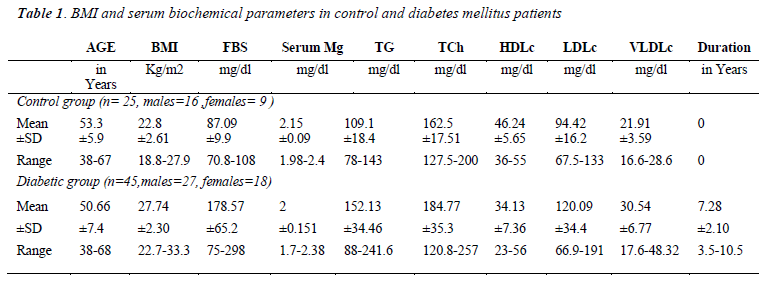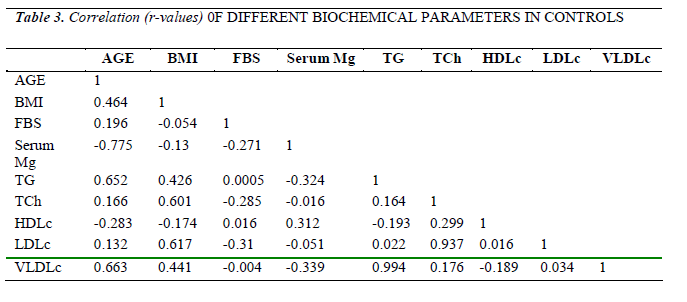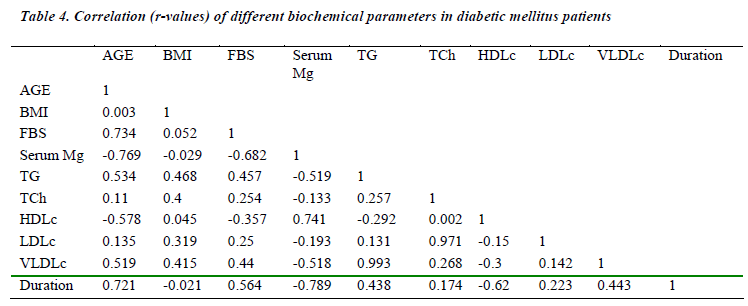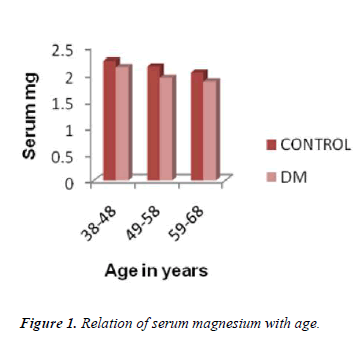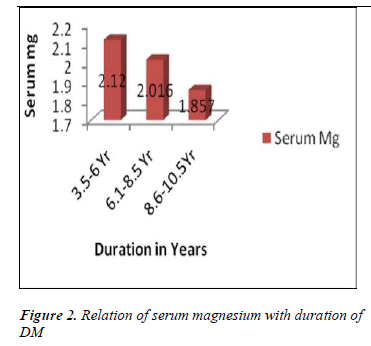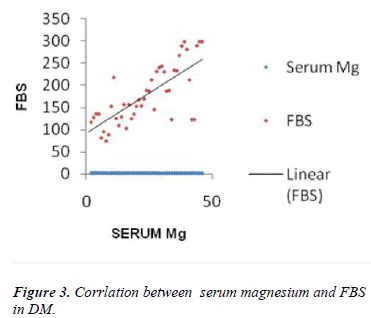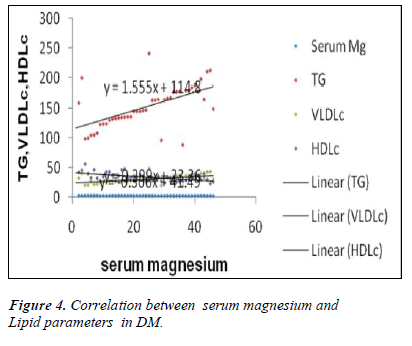ISSN: 0970-938X (Print) | 0976-1683 (Electronic)
Biomedical Research
An International Journal of Medical Sciences
- Biomedical Research (2012) Volume 23, Issue 2
Serum Magnesium and Dyslipidemia in Type-2 Diabetes Mellitus
Department of Biochemistry, Aarupadai Veedu Medical College and Hospital, Puducherry-607402, India
- *Corresponding Author:
- Sasmita Mishra
Department of Biochemistry, A.V.M.C and Hospital
Puducherry 607402, India
Accepted date: July 09 2011
Hypomagnesaemia is a common feature in patients with type-2 diabetes. It may be a cause or consequence of diabetes. This study was designed to find out the serum magnesium levels and its influence on serum lipids, in type 2 diabetics and how it is associated with the duration & complication of the disease. 45 known diabetic patients and 25 controls were taken for the study in and around Puducherry. The mean length of time the patients were diagnosed as diabetics were, 7.28 (± 2.1) years. This period was taken as the duration of disease. The serum magnesium and HDLc were significantly lowered (p<0.001) and all other lipid profile levels (TG, TCh, LDLc, VLDLc) were significantly higher (p<0.001) in cases. Our correlation study revealed a significant negative association between Serum Magnesium (Mg) and fasting plasma glucose and duration of the disease expressing its role in complication processes. Serum Mg also depicted significant negative relation with TG and VLDLc (r= -0.519,r = -0.518) and positive relation with serum HDLc (r =0.741), which explains associative evidence of its role in dyslipidemia. Our study substantiates the known importance of Mg supplementation in diabetics to prevent complications.
Keywords
Serum magnesium, serum lipids, diabetes mellitus
Introduction
Magnesium (Mg) is an important intracellular cation that is distributed into three major compartments: mineral phase of bones (65%), intracellular space (34%) and extracellular fluid (1%) [1]. Magnesium is needed for more than 300 biochemical reactions in the body. Magnesium helps to regulate blood sugar levels, promotes normal blood pressure, and is known to be involved in energy metabolism and protein synthesis [2,3]. Diabetes mellitus is a metabolic disease of growing concern. Type-2 diabetes is characterized by insulin resistance and usually relative insulin deficiency. Most of these patients are obese and at increased risk of developing macro vascular complications. In these patients insulin secretion is defective and insufficient to compensate for the insulin resistance [4].
Magnesium plays an important role in carbohydrate metabolism. It may influence the release and activity of insulin, the hormone that helps to control blood glucose levels [5]. Low blood levels of magnesium are frequently seen in individuals with type-2 diabetes. Hypomagnesaemia may worsen insulin resistance. The kidneys possibly lose their ability to retain magnesium during periods of severe hyperglycemia (significantly elevated blood glucose). The increased loss of magnesium in urine may then result in lower blood levels of magnesium [6]. Insulin resistance and magnesium depletion result in a vicious cycle of worsening insulin resistance and decrease in intracellular Mg2+ which limits the role of magnesium in vital cellular processes [7]. But various studies have given contradictory results [8,9].
Other studies show association of low serum magnesium with dyslipidemia in type-2 diabetes mellitus (DM) [10]. A number of studies have reported beneficial effects of magnesium supplementation on plasma cholesterol and LDLc (low density lipoprotein-cholesterol), and an increase of HDLc (high density lipoprotein-cholesterol) level [11-13]. Indeed, controversial reports are available regarding the effect of magnesium (Mg) on lipid profile and glycaemic control in diabetic patients [14].
Very few Indian studies have correlated all these parameters in DM patients. Due to the increasing prevalence of DM in India, we decided to explore the association of serum magnesium in Type 2 Diabetes with the established biochemical parameters.
Considering the above facts, the present study was conducted with an objective to evaluate the serum magnesium, fasting sugar and lipid profile in type-2 diabetes cases & to compare them with the controls and to correlate them, with other parameters.
Materials and Methods
The present study was conducted by the Department of Biochemistry, Aarupadai Veedu Medical College (A.V.M.C); Puducherry. Forty-five type-2 DM patients within age group of 38-68 years attending the Diabetic OPD and Medicine Indoor of A.V.M.C Hospital were included in this study. Type-2 DM patients were diagnosed on the basis biochemical investigations as per WHO criteria [15].
Twenty-five age and sex matched apparently healthy individuals with normal plasma glucose & with no symptoms suggestive of DM were taken as controls. Patients with acute & chronic inflammatory conditions, other metabolic conditions like ketoacidosis, cerebrovascular disease or renal diseases as well as smokers, alcoholics, and primary hypertensive were excluded from the study. All the diabetics were under treatment with oral hypoglycemic agent or insulin - Insulin crystal injections with various dosages. None of the subjects were on lipid lowering drugs. The study was approved by the institutional ethical committee. Body mass index (BMI) was calculated using the standard formula (weight in kilograms /height in meter-square: kg/m2) to exclude obesity.
Both cases and controls were subjected to estimation of biochemical parameters. Blood samples were collected in fluoride tube for glucose and Clot activator tubes for other estimations after an overnight fast.
Fasting plasma glucose, serum cholesterol, triglyceride, and HDLc were estimated by using commercially available kits in Cobas Mira plus RS-232, Swizerland, automated analyzer. Serum LDLc and VLDLc (very low density lipoprotein-cholesterol) were calculated by Friedwald's equation [16].
Specific tests for serum Magnesium was done by collecting the blood in heparinized green capped plastic tube. Magnesium was estimated by a kit purchased from Reckon Diagnostics, India that uses calmagite dye method [17]. The reference serum or plasma magnesium level by this method is 1.6-2.5 mg/dl. The principle of this method is that magnesium forms a purple coloured complex when treated with Calmagite dye in alkaline solution, chelating agent and detergent present in the reagent will help out interference occurring from Calcium and Proteins. The intensity of the purple colour is proportional to magnesium concentration.
Statistical analysis
The data was analysed using Microsoft excel 2007. For the comparison of values between the groups, students‘t’ test was used, represented by P value. Statistical significance was considered at P value < 0.05. For the correlation, Pearson’s' correlation coefficient was used. Column charts are used to compare values across categories. Scatter chart was used to compare pairs of values.
Results
The age distribution of patients and controls were between 38-68 years (Table 1). Out of 45 diabetic patients 27 were males and 18 were females. Out of 25 controls 16 were males and 9 were females. BMI (Table-1) of diabetics were found to be more than the controls (p<0.001). Routine Biochemical investigations registered a significant rise (p < 0.001) of fasting plasma glucose, Triglycerides( TG) ,Total Cholesterol (TCh), LDLc and VLDLc in diabetics, in comparison with controls (p<0.001) (Table 2).
Significant alterations in lipid parameters show association of dyslipidemia in DM. There was significant fall in both Serum magnesium and HDLc (p<0.001) in diabetics than controls. Serum mg was found to be lower in diabetics than controls, but within the normal reference range.
There was a significant negative association between serum magnesium and age of both control and cases (r= - 0.77, p <0.001; r = -0.769, p < 0.001) (Tables-3, 4 and Figure-1). In cases, the serum magnesium had significant negative correlation with TG and VLDLc (also negatively related to TCh and LDLc ) and strong positive association with HDLc (Table-4) (Fig-4).This might point out the contributory role of magnesium towards dyslipidemia.
Similarly in diabetic group serum magnesium depicted significant negative relation with Fasting blood sugar (r= -0.68, p<0.001) (Fig. 3) and duration of the disease in years( r= -0.78 ,p< 0.001) (Figure 2).expressing the role of magnesium towards complications of diabetes.
Abbreviations used in text:
Diabetus Mellitus---DM
Magnesium----Mg
FBS---Fasting blood sugar
Discussion
Magnesium is a cofactor for several enzymes involved in carbohydrate metabolism. There is a strong relationship between magnesium and insulin action. Magnesium is important for the effectiveness of insulin. A reduction of magnesium in the cells strengthens insulin resistance [18,19]. A poor intracellular magnesium concentration, as found in uncontrolled type-2 diabetes mellitus and in hypertensive patients, may result in a defective tyrosinekinase activity at the insulin receptor level [20]. The intracellular enzyme; tyrosine- kinase requires magnesium to allow insulin to exert its blood-sugar-lowering effects. In several studies, daily oral magnesium supplementation substantially improved insulin sensitivity by 10 percent and reduced blood sugar by 37 percent [21,22]. Hypomagnesaemia can increase platelet reactivity, increase vascular and adrenal responses to angiotensin II, enhance thromboxane A2 (TXA2) release, and lead to organ damage from free radicals [23,24].
The principal findings of the present study was a significant inverse correlation of serum Mg with age in both DM as well as normal controls which is similar to the findings of Nasri et al [10]. We got a significant negative correlation of serum Mg with fasting blood sugar and duration of the disease in diabetic patients. Hypomagnesaemia has been observed in both animal [25,26] and human subjects with type 1 and type 2 diabetes mellitus [27,28]. The etiology of hypomagnesemia in diabetes cannot be clearly explained and serum magnesium levels have been shown to be inversely related to the severity of diabetes [29]. The mechanisms of long-term complications of diabetes are not clearly explained, and hypomagnesaemia may be a contributing factor to these complications, particularly ischemic heart disease [19], retinopathy [30,31] and bone loss [32].
In our study there was significant inverse correlations of serum Mg with serum TG, VLDLc and a positive correlation with HDLc in diabetic patients. In a study conducted by Lal et al. a significant fall in serum total cholesterol, LDL cholesterol and triglycerides and a rise in HDL cholesterol levels was observed after initiation of magnesium supplementation and continued till the end of the study i.e.12 weeks. They concluded that Mg supplementation resulted in a beneficial effect on the lipid profile of these patients [33]. The usefulness of chronic magnesium supplementation in reducing plasma cholesterol and LDL cholesterol, and in increasing HDL cholesterol was also shown by Corica et al [34] and Baydas et al [35]. We also got inverse correlations of serum Mg with serum TG and VLDLc and positive correlation with HDLc levels, a finding which further supports the importance of Mg supplementation in diabetes mellitus patients.
According to ADA (American Diabetes Association) , serum magnesium levels should be measured in diabetes patients at high risk for magnesium deficiency who have diabetes with concomitant conditions like Acute myocardial infarction, Calcium deficiency, Congestive heart failure, Ethanol abuse, Ketoacidosis, Long-term parenteral nutrition, Long-term use of certain drugs (such as diuretics, digoxin, or aminoglycosides) ,Potassium deficiency and Pregnancy. ADA recommends that magnesium levels should be measured in such patients and repleted if deficient [36]. Our study suggests that diabetic patients should take magnesium rich foods like whole grains, legumes, fruits and vegetables (especially dark-green, leafy vegetables) every day which will help to provide recommended intakes of magnesium and maintain normal storage levels of this mineral. Dietary intake of magnesium can often restore mildly depleted magnesium levels but magnesium supplementation is required to restore very low magnesium levels to normal. However, the association between lipid abnormalities and hypomagnesaemia has not been fully understood in humans and need further studies.
References
- Levine C, Colburn JW. Magnesium, the mimic/antagonist of calcium. N Engl J Med 1984; 19: 1253-1254.
- Wester PO. Magnesium.Am J Clin Nutr 1987; 45: 1305-1312.
- Saris NE, Mervaala E, Karppanen H, Khawaja JA, Lewenstam A. Magnesium: an update on physiological, clinical, and analytical aspects. Clinica Chimica Acta 2000; 294: 1-26.
- Alvin CP. Harrison’s Principles of Internal Medicine. 16th Edition. McGraw-Hill; 2005.
- Kobrin SM and Goldfarb S. Magnesium Deficiency. Semin Nephrol 1990; 10: 525-35.
- Institute of Medicine. Food and Nutrition Board. Dietary Reference Intakes: Calcium, Phosphorus, Magnesium, Vitamin D and Fluoride. National Academy Press. Washington, DC, 1999.
- Hua, H : Gonzales, J : Rude, R K .Magnesium transport induced ex vivo by a pharmacological dose of insulin is impaired in non-insulin-dependent diabetes mellitus. Magnes-Res 1995 Dec; 8 (4): 359-66.
- Kao WHL,Folsom AR, Nieto FJ, MO JP, Watson RL, Brancati FL. Serum and dietary magnesium and the risk for type 2 diabetes: The Atherosclerosis Risk in Communities Study. Arch Intern Med 1999;159 :2151-59.
- De Lourdes Lima, M, Cruz T, Pousada JC, Rodrigues LE, Barbosa K, Canguco V. The effect of magnesium supplementation in increasing doses on the control of type 2 diabetes. Diabetes Care 1998; 21:682-86.
- Hamid Nasri.Lipid in association with serum magnesium in diabetes mellitus patients. Acta Angiol ; 12 (4): 149-154.
- Yokota K, Kato M, Lister F, et al. Clinical efficacy of magnesium supplementation in patients with type 2 diabetes. J Am Coll Nutr. 2004 Oct; 23(5):506S-9S.
- Rasmussen HS, Aurup P, Goldstein K, et al. Influence of magnesium substitution therapy on blood lipid composition in patients with ischemic heart disease A double-blind, placebo controlled study. Arch Intern Med.1989 May; 149 (5): 1050-1053.
- Hagg E, Carlberg BC, HillronVS, Villumsen J . Magnesium therapy in type 1 diabetes. A double blind study concerning the effects on kidney function and serum lipid levels. Magnes Res 1999; 12: 123-130.
- Gullestad L, Jacobsen T, Dolva LO. Effect of magnesium treatment on glycemic control and metabolic parameters in NIDDM patients. Diabetes Care 1994; 17:460-461.
- Diabetes Mellitus reports of WHO study group .Tech Rep Ser 1985; 727: 1-113.
- Friedewald WT, Levy R, Fredrickson DS. Estimation of the concentration of Low-density lipoprotein cholesterol in plasma without use of the preparative ultracentrifuge. Clin Chem 1972; 18: 499-502.
- Maxwell H, Abernethy, Richard T. Flower. Micellar Improvement of the Calmagite Compleximetric Measurement of Magnesium In Plasma. Clin.Chem1982; 28/3:520-522.
- Paolisso G, Scheen A, D ‘Onofrio F, Lefebvre P. Magnesium and glucose homeostasis. Diabetologia 1990; 33: 511-514.
- Nadler JL, Buchanan T, Natarajan R, Antonipillai I, Bergman R, Rude R: Magnesium deficiency produces insulin resistance and increased thromboxane synthesis. Hypertension1993; 21: 1024-1029.
- Barbagallo M, Dominguez LJ, Galioto A, Ferlisi A, Cani C, Malfa L, Pineo A, Busardo’ A, Paolisso G. Role of magnesium in insulin action, diabetes and cardio-metabolic syndrome X. Mol Aspects Med 2003, Feb-Jun;24(1-3): 39-52.
- Guerrero-Romero F, Tamez-Perez HE, Gonzalez-Gonzalez G et al. Oral magnesium supplementation improves insulin sensitivity in non-diabetic subjects with insulin resistance. A double-blind placebocontrolled randomized trial. Diabetes Metab 2004 Jun; 30 (3): 253-258.
- Rodriguez-Moran M and Guerrero-Romero F. Oral magnesium supplementation improves insulin sensitivity and metabolic control in type 2 diabetic subjects: a randomized double-blind controlled trial. Diabetes Care 2003Apr; 26(4): 1147-1152.
- Nadler JL, Malayan S, Luong H et al . Intracellular free magnesium deficiency plays a key role in increased platelet reactivity in type II diabetes mellitus. Diabetes Care1992; 15: 835–841.
- Altura BM, Altura BT . New perspectives on the role of magnesium in the pathophysiology of the cardiovascular system: clinical aspects. Magnesium1985; 4: 226-244.
- Mooradian AD, Morley JE. Micronutrient status in diabetes mellitus. Am J Clin Nutr1987;45: 877–895.
- Cadell JL . Magnesium in perinatal care and infant health. Magnes Trace Elem(1991-1992);10: 229-250.
- Vanroelen WF, Van Gaal LF, Van Rooy PE, De Leeuw IH. Serum and erythrocyte magnesium levels in type I & type II diabetics. Acta Diabetol Lat 1985;22: 185–190.
- Smith RG, Heise CC, King JC, Costa FM, Kitzmiller JL.Serum and urinary magnesium, calcium and copper levels in insulin dependent diabetic women. J Trace Elem Electrolytes Health Dis1988; 2: 239-243.
- Streter DHP, Gerstein MM, Marmor BM, Doisy RJ. Reduced glucose tolerance in elderly human subjects. Diabetes 1965; 14: 579-583.
- Ceriello A, Guiglano D, Dello Russo P, Passariello N. Hypomagnesaemia in relation to diabetic retinopathy. Diabetes Care 1980; 5: 558-559.
- Ishrat Kareem, S.A. Jaweed, J.S. Bardapurkar, V.P. Pati. Study of Magnesiun, Glycosylated haemoglobin and lipid profile in diabetic retinopathy. Indian Journal of Clinical Biochemistry 2004; 19 (2): 124-127.
- Rude K, Adams JS, Ryzen E et al. Parathyroid hormone secretion in magnesium deficiency. J Clin Endocrinol Metab 1985; 61: 933-940.
- Lal J, Vasudev K, Kela AK, Jain SK .Effect of oral magnesium supplementation on the lipid profile and blood glucose of patients with type 2 diabetes mellitus. J Assoc Physicians India 2003; 51: 37-42.
- Corica F, Allegra A, Di Benedeto A et al . Effects of oral magnesium supplementation on plasma lipid concentrations in patients with non-insulin-dependent diabetes mellitus. Magnes Res1994; 7: 43-47.
- Baydas B, Karagos S, Meral I . Effects of oral zinc and magnesium supplementation on serum thyroid hormone and lipid levels in experimentally induced diabetic rats. Biol Trace Elem Res 2002; 88: 247-253.
- American Diabetes Association. Nutrition recommendations and principles for people with diabetes mellitus. Diabetes Care 1999; 22: 542-545.
